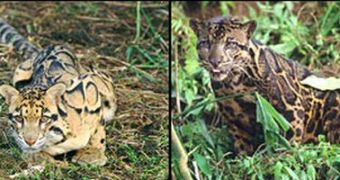We are now looking for life "out there", beyond Earth; and from time to time, scientists discover unimaginable surprises: big beasts here on Earth that passed unobserved.
The current such discovery is not a creature from the bottom of the oceans, but a big cat, up to 23 kg (58 pounds) from the islands of southeastern Asia: the clouded leopard of the islands of Borneo and Sumatra.
The shy rainforest animal was originally believed to belong to the same species as the individuals encountered in mainland Southeast Asia (Indochina, southern China and northeastern India) but genetic analysis made at the U.S. National Cancer Institute revealed that the difference between the two clouded leopard forms are similar to those between other large cat species like lions, tigers, and jaguars.
The new species seems to have split from the clouded leopard found on the mainland Asia some 1.4 million years ago. "Genetic research results clearly indicate that the clouded leopards of Borneo and Sumatra should be considered a separate species," said Dr Stephen O'Brien, Head of the Laboratory of Genomic Diversity, U.S. National Cancer Institute. "DNA tests highlighted around 40 differences between the two species."
Comparisons made between fur patterns and coloration of skins in the two species further enhanced the genetic evidence. "The moment we started comparing the skins of the mainland clouded leopard and the leopard found on Borneo and Sumatra, it was clear we were comparing two different species. It's incredible that no one has ever noticed these differences", said Dr Andrew Kitchener, from the Department of Natural Sciences, National Museums Scotland and lead author of the scientific paper that described the new species.
The new species is darker than the mainland one, it presents small cloud markings, a lot of distinct spots within the cloud markings and a double dorsal stripe.
Clouded leopards from the mainland present larger clouds and fewer, often light spots within the cloud markings; their color is lighter, more tawny than gray with a partial double dorsal stripe. "Who said a leopard can never change its spots? For over a hundred years we have been looking at this animal and never realized it was unique. The fact that Borneo's top predator is now considered a separate species further emphasizes the uniqueness of the island and the importance of conserving the Heart of Borneo", said Adam Tomasek, head of WWF's Borneo and Sumatra program.
In Borneo, clouded leopards are the biggest cats, while in Sumatra they are oversized only by Sumatran tigers. 5,000 - 11,000 clouded leopards are estimated to live in Borneo, while the Sumatran population is estimated at 3,000-7,000 individuals.
Big individuals can be as large as small common leopards and, amongst living cats, this one has the longest fangs relative to body size. Its main menace is habitat destruction.
The last great forest habitat for the Bornean Clouded Leopard is the Heart of Borneo, a protected mountainous rainforest region, the size of Kansas (220,000 square km), protected by all three Bornean governments - Brunei, Indonesia and Malaysia.

 14 DAY TRIAL //
14 DAY TRIAL //